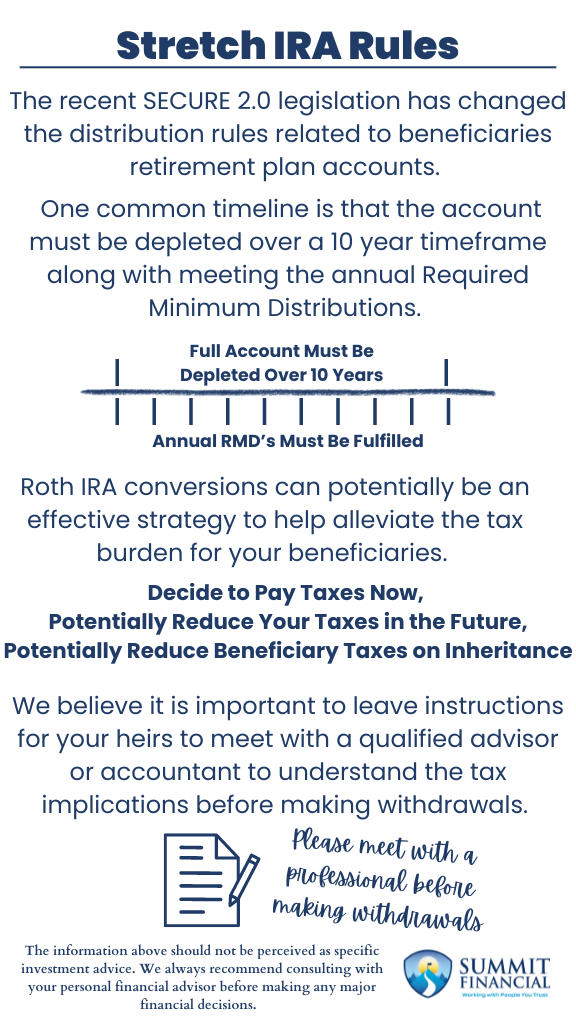The recent SECURE 2.0 legislation has changed a handful of rules pertaining to retirement accounts, including the distribution requirements of beneficiaries.
Key Changes in Distribution Requirements
Previously, the rules were more lenient, allowing beneficiaries to extend the annual required minimum distributions over their expected lifetime. This has been changed, and now we see one common situation: beneficiaries are required to withdraw the full retirement account within a 10-year timeframe.
Receiving an account after your spouse passes away will still allow you to use your life expectancy for the annual RMD calculations. Beneficiaries who are less than 10 years younger than the original owner or beneficiaries who are chronically ill also do not have to fulfill the 10-year account depletion requirement. In addition, some beneficiaries, such as trusts, only have 5 years to withdraw the funds from the account. For more details on these requirements, check out our previous post: Choosing an IRA Beneficiary.
Roth Conversions to Alleviate Tax Burden
For those who expect to leave a sizable amount of pre-tax assets to their beneficiaries, we believe utilizing annual Roth Conversions can help alleviate the tax burden when withdrawals are made. Since Roth monies are not taxable at the time of withdrawal, it is often more advantageous to leave Roth money to your beneficiaries.
This is due to the fact that, especially if they are still in their working years, pre-tax IRA withdrawals will be added to their income and taxed at their income tax bracket rates. We typically speak with clients about Roth Conversions regarding their retirement tax savings, but considering the tax bracket of beneficiaries will reinforce the strategy.
By moving money from a Traditional IRA to a Roth IRA, the owner can potentially reduce taxes during their retirement by converting the funds while in a lower tax bracket. They can also reduce the taxes that may be owed by the beneficiaries when the account is inherited. To learn more about Roth IRA Conversions, read our previous post: Roth IRA Conversion.
Withdrawal Planning for Beneficiaries
Understanding the tax implications of withdrawals from an Inherited IRA can be confusing for some, especially when trying to figure out how to pay the least amount in taxes over the 10-year timeline.
We have seen some beneficiaries who receive an IRA Inheritance and want to withdraw the entire account as soon as they receive it. Withdrawing the entire account in one year would add the entire balance to your taxable income, which would potentially trigger the most amount of taxes possible.
We typically advise heirs that they should try to stretch out the withdrawals over the entire 10 years to limit the amount of taxable income in any given year. This base strategy could potentially reduce taxes, but it becomes even more powerful when we know the beneficiary will have a drop in income during the 10 years and can plan withdrawals accordingly.
For example, if the beneficiary is going to retire in year 5 then they will normally see a big drop in income. For this case, it may be more beneficial to just take the RMDs for years 1-4 and then deplete the majority of the account over the years 5-10 when they have lower employment income.

Guidance and Instructions for Heirs
These types of situations may require a professional’s advice for the beneficiary to understand. This is why we normally suggest a letter of instruction to be included in our client’s estate planning documents so that the heirs will know that their withdrawal decisions may heavily impact their taxes due and the net amount they will receive from the inheritance.
A simple letter to the beneficiaries asking them to meet with a professional before processing any withdrawals can potentially make a big difference in the outcome of the inheritance. Everyone has a unique situation, so recommendations are never a one-size-fits-all, and receiving professional advice can help the beneficiary learn what is best for their situation.
Key Takeaways on SECURE 2.0 Legislation and Planning for Beneficiary Distributions
- The recent SECURE 2.0 legislation has changed the distribution rules related to beneficiaries retirement plan accounts.
- One common timeline is that the account must be depleted over a 10-year timeframe along with meeting the annual Required Minimum Distributions.
- Roth IRA conversions can potentially be an effective strategy to help alleviate the tax burden for your beneficiaries.
- We believe it is important to leave instructions for your heirs to meet with a qualified advisor or accountant to understand the tax implications before making withdrawals.
Financial Planning and Review Meeting
If you have any questions about your investment portfolio, tax strategies, our 401(k) recommendation service, or other general questions, please give our office a call at (586) 226-2100. Please feel free to forward this commentary to a friend, family member, or co-worker. If you have had any changes to your income, job, family, health insurance, risk tolerance, or your overall financial situation, please give us a call so we can discuss it.
We hope you learned something today. If you have any feedback or suggestions, we would love to hear them.
Best Regards,
Zachary A. Bachner, CFP®
with contributions from Robert Wink, Kenneth Wink, and James Wink
If you found this article helpful, consider reading:
- Considerations for Responsible Credit Card Use
- Observations from High Net Worth Individuals
- Employer Retirement Plans
Sources:


